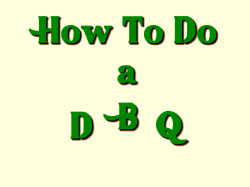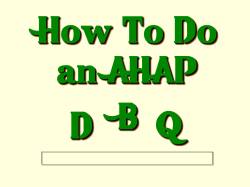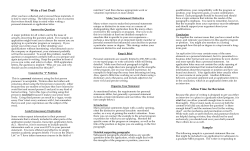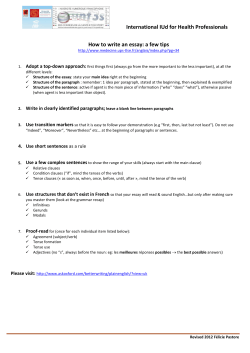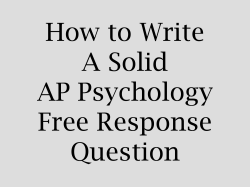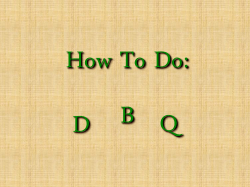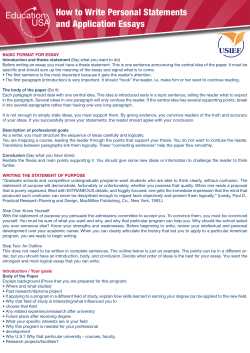
Document 242943
WILLIAM F. BUCKLE,Y JR.
Why Dont We Complain (pp.6a-70)
SUGGESTED
APPROACHES
"Why Dont We Complain?" presents an easy-to-read argument on a familiar topic that shouid appeal to our students. The essay can be viewed as a model argument that moves deductively from a
particular experience to generalizations and claims about broad issues. Students might'discuss
Btrckleyt use of that rhetorical process. Sureiy some may regard his general conclusions as too
sweeping or too broad; others wili doubtless agree with them.
The teacher migirt begin by having the class read lhe first three paragraphs,
speaker relates his experience aboard the train. In their notes, students would write
gr-zrphabout a sirnilar uncomfortable experience thcy have had. They would then
paragraph 8, at which point they would stop and identify Buckley's argument.
method to deduce Bucldey's rationale is Stephen Toulmin's model for argument
Appendix).
in rvhich the
a brief pararead throttgh
An excellent
analysis (see
Once students know the Toulmin model, they will be fan'riliar u'ith the follorving sentence
therefore
since-.
In analyzing an arguconstmction: Because
ment, they r,r'ould filI in rhe first blank with the data or support, thc second with the assertion, or
tacit-is
the asclaim, and the third with what Toulmin calls the warrant. A warrant-usually
sttmption necessarily shared by the speakeq, or writerl and the audience that establishes tl-relogical
connection bet'uveenthe data and the claim. With this formula, a claim seems like not merely an
assertion but rather a logiczrlconclrrsion. Totrlmin's rrodel is applied quritesimply: Because.such an
approach helps students understand the elernents of argument, therefore it is a vaiuable pedagogical technique, siuce gi-eater understanding arnong our sttrdents is a desirable qtrality. We see here,
of course, Lhat our support is actually a clain. Teachers and their stucienls may lest that claim in
ctass.
After discussing Buckley's claims thror-rgh paragraph 8, the class would continue to read
through paragraph 18, discussing his reluctance to coriplain, his subseclueirt resolution to do so
and its ironic concltrsion at the ski-repair shop. B'"rcldeyt anecdotes serve to surpport his concluding claim about Americans'passivity.
. f
QUESTIONS
1.
ONI RI{ETORIC
AND STYLE
Buckley begins his essay with a specific example before he identifies his topic or states his
thesis. What is the effect of such an approach?
Does Bucldey'smethod at the beginning appeal n-loreto ethos, logos, or patl-ros?Explain.
Note Buckley's diction. What is the effect of "virile" in paragraph 2? Of "fTeemen"irr palagraph 3?
Explain the rb.etorical {unciion of paragraph 4.
Using the "because,therefore, since" format, write statements of the claims made in paragraph 8.
Note the parallel structures Buckley uses to formulate his claims in paragraph 8. Explain the
effect.
Explain the purpose 4nd effect ofthe phrase "in sharp focus" in paragraph 8.
What is the purpose of the statement "Strike that iast sentence"in paragraph 10?
What purpose is servedby the ironic incident related in paragraphs 13-17?
Write statements of the ciaims Buckley makes in paragraphs 19 and 20. Use the "because,
therefore. since" formar.
17
Siir;
g':.:
g
gr.
5
Bucklc:y/ \'vlry D o rz't'nVeContplain ?
1 1.
Explain the implied connection between Buckiey's final two examples. Do yon agree with the
conclusion he draws from them?
SIMUI.ATED
rltlii
AP ESSAY QUESTIOI{S
1.
Analysis.
Read the first eight paragraphs of Buckley's "Why Don't We ComRhetorical
plain?" and write a well-organized essay in rvhich you analyze the rhetorical strategies the
writer uses to convey his views regarding passive compliance.
2.
Carefully read paragraphs 18 through 23 of Bucldey's "Why Dont We
Rhetorical Analysis.
andanalyze
the rhetorical str:ategies the lrrriter Lrscs to cor1."'eyhis r.riqlr;5regardComplain?"
the
complaint.
nalure of
ing
Read paragraph S of "Why Don't We Complain?" anci write an essa)i irr r.irhich
you clefend, challenge, or qualify Bucldeys ideas about our "passive compliance" and "heed]ess endr-rrance." Use such evidence as )/oll consider most important.
3 . Al'gurrtent.
4.
rlrgument. Read paragraphs 19 and 20 of "Why Don't lVe Conrplain?" and wrile an essay
in which you support, refute, or qualify Buckleyt ideas about assertivenessand helplessness.
Use evidencefi'om your reading, observation, and experienceto support your argument.
d'
MULTIFLE-CFIO {CE QUESTIO hIS
questiortsrefer to paragrcLp/,zs
1-9 of the essay.
Thesemurltiple-choice
1.
2.
In the first threeparagraphs,Buckleypresents all of the follo'"vingcontrasts EXCEpT
a. insicleand outside
b. present ancl past
c. asscrtivenessand complacency
d. discomfort and comfort
e. action and submission
4.
Which of the following words [r-om paragraphs I and 2 is intended to be ironic?
a. resentful
b. doleftrl
'
c. freemenr
d. dehydration
(r
e. stupor
5.
3 . Which of the following describes the organizational method of the passage?
a. movement from general principles to
specific examples
b. development of qualifications to underlying assumptions
c. movement from specific examples to
' general conclusion
d. presentation of argument and counterargument
e. progress foom descriptive narration
to detailed exnosition
Paragrapir4 serveswhich of the followir-rg
rhetorical ftinctions?
L It provides a transition between the
specific argLrmerrtsin lhe perragraphs before and arlter it.
II. It qualifies and challengesa position
developedin the previorrsparagraph.
III. It extendsthe exampleof previous paragraph to a more generai application.
a. I onlyb. II only
c. I and II only
d. I and III only
e. I, II, and III
))llu
The writer useseach of the following EXcEpr
a. anecdotal naration
b. personal experience
c. specific observation
d. statement of opinion
e. expert testimony
D),wj
1B
Bu"ckley/WhyDonI We Complain?
6.
ParcgraphT serveswhich of the following
rhetoricai functions?
I. It draws a connection between the
two examples given in the preceding
paragraphs.
il. It provides possible solutions to some
of the complaints raised in earlier
paragraphs.
It presents factual information as
il.
supporl for the claims made in previous paragraphs.
a. I only
b. II only
c. I and II only
d. I and III only
e. I, II, and III
7.
Paragraph 8 concludes with a tone of
a. admonition
b. ambiguity
c. uncertainty
d. disappointment
e. encouragemen[
8.
The final phrase of paragraph B, "-itt
sharp focus," derives its power from
which of the following?
I It provides a linguistic connection to
an event related earlier.
II. It emphasizes the importance of the
action enjoined.
nL It provides transition to the ideas introduced in the next paragraph.
a. I only
b. II only
c. I and II only
d. ,I and III only
e. II and III onlv
SUGGESTED WRITING ASSIGNMENTS
1.
2.
3.
Think of a situation similar to the ones describedby Buckley. Relale the incident and develop
a general conclusion from the specific examples you narrate
Compare the rhetorical strategies that Buckley usesin his essaywith those of one of the following from 50 Essays:
n "What's Wrong r,vith Animal Rights?" by Vicki l{earne
. "There Is No Urrmarked'Woman" by Deborah Tannen
" "Television: The Piug-ln Drug" by Marie Winn
Read careftilly the concluding section of "Television: The PIug-In Drug." Write an essay in
which you compare \Alinn's and Buckleyp*viervs of what Buckley calls the "technification of
life" in America.
CONNECTIONS
INSIDE
INSIDE
Essays for comparison
a
e
a
a
AND
OUTSIDE
of argument
50 ESSAYS
strategy:
"Women's Brains" by Stephen Jay Gould
"What's Wrong with Animal Rights?" by Vicki Hearne
"What Are Homosexuals For?" by Andrew Sullivan
"There Is No Unmarked \Moman" by Deborah Tannen
"Television: The Plug-In Drug" by Marie Winn
OUTSIDE
The following pieces provide insight into the nature of apathy:
c
e
t
"The Unknown Citizen" by W. H. Auden (poem)
Rhinoceros by Eugene Ionesco (play)
Arnusing Oursehtesto Death by Neil Postman (media criticism)
I9
STEPHANIE,E.RICSSON
The Ways We Lie (pp.120-2e)
SUGGESTED,A.PPROACHES
Unfortunately, given the current state of world affairs, this essay has immediate appeal and relevance, and students will have no difficulty finding contemporary examples of the categories that
Stephanie Ericsson enumerates. Investigations srlrrorrnding 9l | 1, the war in Iraq, politics at the iocai and global levels as well as celebrity gossip are foclcler for student writing about different types
and modes of lying to oneself and others. To focus rnore narrowly and encourage student reflection, the teacher might discuss Ericsson's categor-iesthrough examples of cheating. When is cheating, for instance, merely a "white lie," or what irind of "ornission" is there in failing to cite
something from the Intgrnet that is not part of an official Web site or pr-rblication?
The structure and style of Ericsson's essay is another imporl-ant topic for analysis. Essentially,
she has an introduction and a conclusion with a series of topics in between. Each topic is introduced
with a subheading, followed by a quote, defined, and then iliustrated with one or more examples.
Does this become monotonous? Is it easier to read than a nrore disculsive essay?Furlhennore, Jlricsson
employs a rather breezy style, dcscribing sorneone r,vho "looks Iil<e hell," incl-rding phrascs such as
"all talk and no walk," and referring to the biblical Lilith saying "adios" as she left the Garden of Eclen.
Such informality speaks to the audicnce, as do the zrutiror's many similes that seem lnore at-theready than original. Students' evaluations of these techniques will inform their ideas about propriety
and intended auclience.
Finallll it is not out of thc quLestionto use an accessjble essay such as this one to i.ntr-oducea
nruch less accessible longer work, such as Ileart of Darlcness, to students. Fr.rrther suggestions are
provided in the Connections section.
QUE,STIONS
ON RHE,TORIC
AND STYLE
1.
Why does Ericsson use a similar reference or discussion pojnt to open and close-and
to frame-her
essay? In what ways does this strategy lead to cohesion?
2.
Identifu examples of informal language in Lhis essay.Is it appropriate and eftective or is it diss
tracting?
.,.f
3.
Examine one section where Ericsson defines a t;4peof lying. How would you describe this
structure? Examine another seiection. Is she repealing or varying the structure?
Do any of Ericssont "t14Des"
of lying seem similar to logical fallacies?Which ones? (For instance, is "deflecting" the same as a red herring?)
What is the intended purpose of the quotations at the start of each type of iie? Are they meant
to be humorous, inspirationaL,ironic?
Ericsson usesher personal experienceto illustrate some but not all of her categoriesof lying.
Is her allotment of personal reference effective,or does it flagment the essay?
List the sourcesof Ericssont examples(such as a businessacquaintance,different authors, the
Bible, Pearl Harbor). Does this variety help her meaning, or is the range too wide to be effective?
Who is Ericsson'saudience for this essay?Is her purpose to accusethem, make them think,
dare them to stop lying-or something else?
How would you describe Ericsson'stone?
4.
5.
6.
7.
8.
9.
thus
SIMULATED AP ESSAY QUESTIONS
i.
R.hetorical Analysis. Carefully read paragraphs 1 through 9 of "The Ways We Lie." Write
an essayanalyz-ingthe rhetorical strategiesthe author uses to achieveher purpose.
35
-sffi
f:i*
rrl'
i..rl
E,ricsson/Ti'Le -vVaysI,Ilc Lie
Argrrment. The following assertion is from paragraph 35 of "The Ways We Lie" by Stephanie
Ericsson:
. . . it's not easyto entireiy eliminate lies from our lives. No rnatter how pious
we rnay try to be, r,ver.vill still embeilish, hedge, and omit to lubricate the
daily machinery of living. But there is a world of difference between telling
ftinctional lies and living a lie. Martin Buber once said, "The lie is the spirit
committing treason against itseif." Our acceptanceof lies becomesa cultural
cancer that eventually shrouds and reorders reality until moral garbage becomes as invisible to ris as .ur,/ater
is to a fish.
lVrite an essayin which yor-rdefencl,challenge,or qualify this statement. Use eviclenceto clevclop yor-rrargllment tl'orn yor-irrt--ading,e;rperience,and obseiwnl-ion.
3. Argument. Author Stephanie Ericsson observedthat "madnessis actually a sane reaction
to an insane .,,rorld."Write an essayanalyzing a character ftom a literary r,vorkin the terms
of tlris sLziteinent.SuggesLions:I(urlz in lfetzrt ctfDrtrkness,the narrator ,-,f'''fhe Yellow Wallpapei" Hedley in King Hedley II, Lear in King,Lea4 Hamlet in Hamlet, the main character in
Girl Interruptecl,the speakerin Emily Dickinson's poein "Much MadnessIs Div.inestSense."
.
f
MULTIPLE.Ctr{OICE QUESTIONS
2.
lili i
i:
x!
3
f
fi
i;
E
F
E
;i
6t
Thesentultiple-choicequestionsrefer to tlte erLtireessay.
1.
Judging lrom her explanations and examples, it can be inferred that Ericsson believes that people
a. LrreLrnaware that thev lie in marrv different ways
3.
b. do not recognize the difference between "functional iies" and harmftil
ones
c. fail to understand the true consequencesof their lying
d. have learned to tolerate lying as a
necessarypart of contemporary life
e. lie unintentionally more often than
they lie intentionally
A
a.
2.
The sentence "We exaggerate, we minimize, we avoid confrontation, we spare
people's feelings, we conveniently forget,
we keep secrets, we justify lying to the
big-guy institutions" (paragraph 3) is an
example of
a. a run-on sentence
b.- a complex senterice
c. polysyndeton
d. asyndeton
e. a cumulative sentence
Which of the follor,vingoutiines.the shared
stmcture of "The White Lie" (paragraphsB
and 9) and "Omission' (paragraphs18-20)?
a. personal experience,explanation of
consequences
b. definition, explanation of consequences,examples
c. definition, personal experience, general examples
d. personal experience, explanation of
conseqllences
e. explanation of quotation, personal
experiences
ii
:w
t))|titt,
)
The section "FaEades"(paragraphs10 and
11) includes all of the following EXcEpr
a. hyperbole
b. metaphor
c. personification
d. colloquialism
e. metonymy
5 . What is the rhetorical function of paragraph 36?
a. to engage readers by accusing them
of wrongdoing
b. to summarize each of the types of lying that have been discussed in the
essay
to encourage readers to 'contrast
"functional lives" with "living a lie"
d . to repeat the most important points
that the author has made in her essay
to encourage the reader to accept her
stated ciaims
36
'
ttrttlitii
Ericsson/The Ways We Lie
6.
Which of the following best describesthe
tone of this essay?
a, didactic and moralistic
b. sarcastic and acerbic
c. lively and provocative
d. nonchalant and informal
e. confrontationalandinstructive
SUGGESTED WRITING ASSIGNMENTS
1.
Z.
3.
4.
Write an essay in which you analyze the rhetorical strategies, including stylistic choices,
Ericsson uses to achieveher purpose in this essay.Addressthe effectivenessofher repeating
strucLure.
Write your own classification essayusing some of the categoriesEricsson delineates,but use
examplesfrom today's politics and/or yolrr own experience.
Write about a time when you or someoneyou know told a "functional" lie that seemeda better
decision than telling the absolirtetruth.
Write your own classification essayon another topic, and use quotations as markers the way
Ericsson does.
CONNECTIONS INSIDE AND OUTSIDE 50 ESSATS
TNSIDE
: "salvation" by I-angston Hughes (also on the personal consequencesof lying)
OU'fSIDE
.
"
.
'
.
Advertising is a perfect source of examplesof Ericsson'scategoriesof lies, particularly the
ones that are less than bald-faced.
George Orwell's essay"Politics and the English Language" (rvww.mthol),oke.edu/acad/intrel/
orv'iell46.htm) is structured as a classification system with subheadingsand numerous
examples.Students might compare and contrast the structure and style of the Orwell and
Ericsson essays.
Not to oversimplifu, but the novel Heart of Darkness turns or-r.questions of truth-how we
knor,vwhat we do, how much we can bear to know and what right others have to make
that clecision for us. Whether Kurtz* is lying to himself to fasf,ion his own reality or
Marlowe lies to Kurtz's fianc6e to pt'6tect her from knowledge that might destroy her, it
is certain that truth is central to Joseph Conrad's novel. Ericsson's relatively straightforward essay might be used as an introduction to the more philosophical issues in this
novel.
In the same serious vein, OedipusRex by Sophocles and The Remains of the Day by Kazuo
Ishiguro concern themselves with forms of lying and their consequences,particularly
self-deceotion.
37
STEPHEN JAY GOULD
Women's Bratns (pp.130-37)
SUGGESTED APPROACHES
Gould is such an extraordinarily fine writer that his essaypresentsan opportunity to study structure and craft at their best. Moreove4,unlike many of the essaysin this collection that are autobiargumentsthat hinge on politics, or zrcombinaiion of the two, Goulci'sess:r1,
ographicalnarr:atives,
urore closely resernb.lesihe academic essaythzrt invoivcs research.It is, iror'vever,far ft-om lhe sluggish prose that has come to be asscciated..vith"acaclemic'.vriting."EIeFramesthe pir:cewith qtroizrtionsfrom GeorgeElioL'sl,[icLcllenrcrclz.
I{e cites scientistsconsiclcrecl
cxpertsin their tirnc, points
out logical fallacies in their thinking, presents counterargumenl-s,and draws ail of hii scientific
n{}intsfoqefhr:r-toarldressa larse.rsocial issurcs1-artecl;rt
the t:ncloI thc essav:". . . the r.vholeenterpriseofsettingabiologicalvaiueupongroups...[is]...irrelevantandhighlyinjurious."
T'he teacher can developspecific "lessons"about craft directly from thi.sessay.Gould's framing techniqLlecan also be replicated through an apecdote,an allusion, or a cl.restion.Students
should note Gould's Frequentand delt incorporatiofr.of rele.vantquotations in the essalr! body I{e
never allor,vscited materials to stand on their own, but instead he carefully prepares the reader for
them, and then makes thematic connections.
To encourage stuclents'appreciation of the cornplexity of Gould's r,vork,the leacher might
want to assign the essayr,vith a dialectical journal homework assignment (seer\ppeirdix). In this
case,the left-hand column could bc where students write clown an intrigr.ringidea Gould raises
himself or via one of his sources;then, in the right colurnn, the student cor-rldcommcnt on it, disagreewith it, or associateit with current-day thinking. Such an anaiytic reading would prepare students for a discussion of both form ancl content in Gor-rld'swork.
)))tttD
)
Another possibility that would emphasize Gould'suse of quotations might be to ask students
to number the quotes (there are nine, including the briefer ones in paragraphs 13 and 14), paraphrase each, then comment on it. This process will help students to seehow the quotations form
the skeleton of Gould's arsument.
QUESTIONS ON RHETORIC AND STYLE
1.
2.
3.
4.
5.
6.
What purposes do the quotations from George Eliot's Middlemarch in,the introduction and
closing of this essayserve?Why does Gould, when introducing the quote from Broca in paragraph 5, refer to Eliot? Why are quotations from Eliot (whose real name r,vasMarian Evans)
especiallyappropriate for Gould's essay?
In paragraph 3 Gould states, "I have the greatest respect for Broca's meticulous procedure.
His numbers are sound." Despite this praise, Gould goes on to refute Bioca's findings. What
vulnerability does Gould find in Broca's conclusions? Does Gould's praise of Broca strengthen
or weaken his own argument? Explain.
In this essay,Gould builds two parallel arguments, one on scientific method, another on speculative conclusions. In which passagesdoes he call into question the scientific method(s)
rather than the findings themselves?
How does each of the persons Gould cites contribute to the development of his argument? Does
each make a separatepoint, or do some reinforce one another?Could any one of them be eliminated without damage to the argument? Include Broca, Le Bon, Manouvrie6, and Montessori.
Gould ends paragraph 8 with the statement, "Never have so little data yielded such far-ranging conclusions." Which logical fallacy is he suggesting?=
In what ways do paragraphs 9 through 12 work as a unit to develop a single point that is integral to the overall essav?
N',lilui;t
r' i1
i-[
i::i'
: . -ta
F
5: &:
,::: t
.
Gould/Women'sBrains
E
I l':F
!,: :E
7.
i,F
l ,F
:::: e
8.
i:F
:E
1r;
f;B
9.
i:'g
i':1F
i:; ft
ir':I
10.
i,i'E
.$
i:
i,".
F
;riE
,tfr
i.':t
; ::t'
;.::F:
i..","h
iJE
SIMULA'IED
1.
2.
d$
i*r
t { 'I
I;F
ifi',
l
:.:.,r.
;i,B
,lli
: ,1,.
ii,F
:
t.
,
. !
t.,,I
''fi
;
,'ti
,..:F:
:;:.1
iLli
iris
l'.,r
::i; l:
'iiiH
.tt$
i,:.I
..,t
,;.i
i].
irf:
i'il
i: ri ii
a..,v.
+jF
j:iiF
i.-: It
:+'F
ri!'i;
,i11H
:i.:1
:=l
irF
"'H
'f+*
.,:rE
:..ii
.;H
.+
:t:f:
.tF
.:f.'iFi
:i.*o,-
AI' ESS'AY QUESTIONS
Rhetorical Analysis. In his essay "Women's Brains," evolutionary biologist Stephen Jay
Gould focuseson theories about the correlation betr,veenbrain size and intelligence.Write an
essay in which you analyze the rhetorical strategies Gould uses to achieve his purpose in
paragnaphs 1 through 7, including foo[note 1.
Argument.
In his essay"Women'sBrains," Gould refers to "a general Lheorythat supported
contemporary social distinctions as biologically ordair:.ed"in the late nineteenth century. In
the twenty-first century many continue to argue for nature over nnLtLrre,supporting biology
as the car.rsalagent for the skills and talents of specific groups.
la[hel than socia]iza1"ion
Write an essaysupporting or refuting the theory that heredity, not environment, is the principal deterininanl of human traits. You may use yoursglf as an example, but yott should also
do some research to explore hor,vthese arguments about human behavior have been used in
particular historicai contexts.
gcncratcdby a quotation,it i.sa naturnl
Nolc: \lr/Liletltis is tLola typicalAP argumentqtLestion.
places
biological delerntinisnt in historiccLlcontext.
outgrowth of Gould'sessay,whiclt
t'
iiiiil
ir':;:l:
In paragraph 13, Goulcl shows how Broca and his colieaguesextended their conclusions to
other groups. Which logical fallacy is he revealing?
Why is questioning Maria Montessorit researchand conclusions a particularly effectivestrategy?
What criticism might Gould be gr-rardingagainst in doing so?
How does Gouid bring togetherboth of his argumentsin the last two paragraphs(i.e.,his argument against the actual scientific research and his argument about the conclusions drawn
from that research)?
Would Gould's essayhave been more effective if he had written it in the third person? Why
or why not?
OICE QUESTIOI{S
]VIULTIPLE,.CFN
Thesemultiple-choicequestionsrefer to the entire essay.
1. What is Gouldi primary purposein opening anclclosing the essaywith a quotation
ft'om George Eliot?
I. to add cohesion to the essay
f
II. to highlight a wbman whose life'refutes the argurnentsGould addresses
IIII. to emphasizethat she wrote under a
pseudonym
a. I only
b. II onlSr
c. I and II only
d. I and III only
e. I, II, and III
2.
What is the purpose of Gouldt parenthetical comment in paragraph 3?
a. to introduce a new idea
b. to present.a counterargument
c. to conrnent on his pi-eferred scien. tific method
d. to support a point made in the previous
paragraplr
e. to anticipate a criticism of his position
3.
By quoting Manouwieq Gould
^. exposeshis own prejudices
b. shows that not all of Broca's colIeaguesagreedwith him
c. provides additional evidence of
Brocat influence
d. challenges the scientific methods on
r,r'hichBroca relied
e. implies that Broca was misunderstood
A
Which of the foliowing rhetor:ical strategies does Gould employ when he cites the
Iengthy quotation from Le Bon in paragraph 6?
a, an appeal to pathos
b. an appeal to logos
c. an appeal to authority
I
L
. , - - - l - ^v]vrrJ
lJvr
ru
e. argument by analogy
Goil.d/Wonten's Brains
5.
'
6.
1
!.
8.
By including tire footnote, on page 133,
Gould
a. admits that he based his initial analysis on incorrect data
b. apologizes for not conducting thorough research
c. notes more recent research that confirms his argument
d. suggests that his argument has even
more far-rerclr i n g conseciLrenccs
e. modifies the positio-ir he statecl at [tre
outset cf the cssay
The sentence at the end of paragraph i3,
"I do not regard as empty rhetoric the
claim that r,vomen's battles are for all of
u s , " i s a n e x a n r p i eo f
a. arltithesis
b. parallel syntax
c. paraclox
d. simile
e. ttnderstatement
10
When Gould asks the question "Sound familiar?" at the end of paragraph 7, he
a. undermines the serior-rsnessof his ar'gument with a flippant remark
b. suggests that the same arguments are
being made today
c. invites his readers to clrar,vtheir or,vn
conclusions
ct. satirizes the argr-rment Le Bon is making
e. inplies that his readers are zilreacly
familiar with Le Bon's arsument
-^--^^L^
rD ^ar.L6L.r1,rro
r1 1r zrcl 12 inch,rcleall of the
following EXcEPT
a. a humorous aside
b. quantitative data
c. an appeal to authority
d. a rhetorical question
e. cause-and-effectanalysis
What is the "antidote" to rvhich Gould
refers in the opening sentence of paragraph 15?
a. his own opinion
b. lvlontessori'sconch-rsions
c. i3rocas lindings
d. the counterargltment to Morgan
e. Le Bon's biased views
t'f1-. The author's tone in this essay can best be
describcd as
a i n r n a l t i a l e . n dl a t i o n a l
b. angry ancl ironic
c. detached and pedantic
d. engaged and logical
e. formal alrd distant
12.
The two strands of arguments that Gould
tosether
--D--*^-_
brinss
-^ _^^Din the conclusion are con-
DDil)
cerned with
a. scientific reasoning and social commentary
b. Broca's theories and Gould's objections
c. scientific methods of the nineteenth
century versus those of the twentieth
century
d. patriarchal views and nonsexist attitudes
e. scientific theory and historical fact
The logical fallacy that Gould exposesin
paragraph 13 is
a. ad hominem
b. circular reasoning
c. slippery slope
d. mistaking cause for effect
e. either-or fallacy
SUGGESTED WRITING ASSIGNMENTS
,1. Write an essayin which you discuss the rhetorical strategies Stephen Jay Gould employs. Pay
p4rticular attention to his use of sources.
2.
J.
4.
The following is an AP-stylequestion, but one that requires some outside research.
Write an essaysupporting or challenging StephenJay Gould's assertion in his essay "Womenb
Brains": "...science.isan inferential exercise,not a catalogof facts. Numbers, by.themselves,
specrfy
nothing. All depend.supon what you do with them." Su{pori your position Uyrelen;.ngto statistics
used in science,politics, economics, sports, or other applicable areas.
Find an essaywritten for a specialized audience (for example, an explanation of some element
of science or technology in a scie2tific journal) and rewrite it for a more lleneral audience.
Write an essayusing scientific data to develop an argument that has ethical or social implications and frame it with a quotation, description, or anecdote.
40
r))Mi
© Copyright 2025
